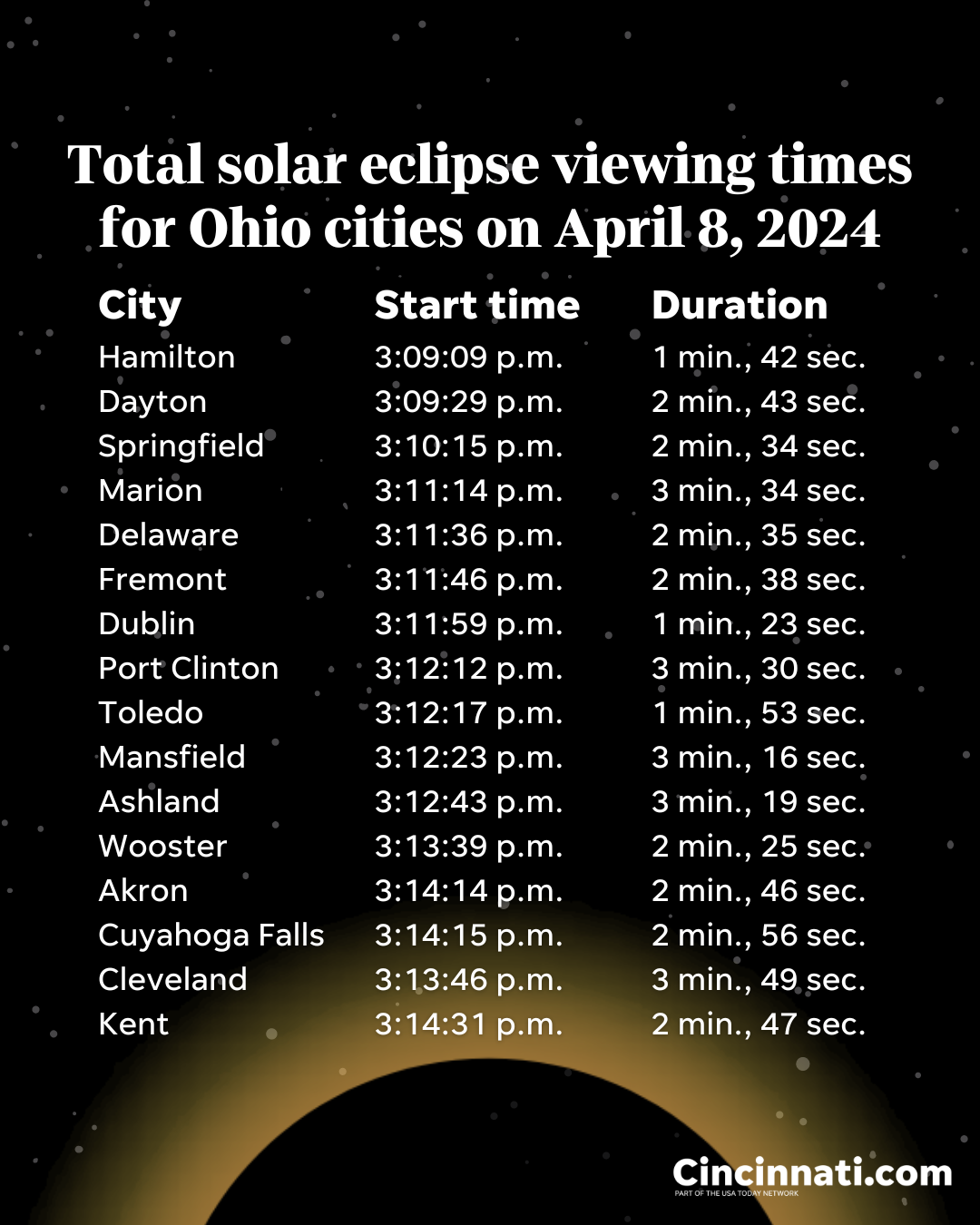Solar eclipse 2024: New interactive map reveals historic weather trends for April 8

Worried about how cloudy it could be in your area for the total solar eclipse on April 8 and looking for a backup plan? Or are you just looking for the best location to see the once-in-a-lifetime event? This new map can help.
The National Environmental Satellite, Data, and Information Service has combined a map created from NASA's 2024 total solar eclipse data with climatology information showing, on average, how overcast April 8 can be in U.S. cities.
For example, Akron is overcast 45.6% of the time that day, based on 30 years of cloudiness observations taken at the nation's airports. Columbus is overcast 42.9% of the time, and Cincinnati is overcast 37.6% of the time.
This is not a forecast, according to the environmental service, but rather a tool that leverages the expertise of National Oceanic and Atmospheric Administration and NASA scientists to provide typical atmospheric comfort (air temperature, heat index and wind chill) and cloud conditions (viewability) during the time of peak totality.
The eclipse is the first in the United States since 2017, and Ohio is lucky enough to be in the path of totality for the first time since 1806.
Where is the path of totality 2024? 'New' path of totality map reveals Ohio will see less of the solar eclipse
According to new data, fewer Ohioans will experience 100% darkness during the 2024 solar eclipse.
That's because, despite modern technology, the sun's radius is difficult to measure. New data shows that the sun is a tad bigger than previously thought. New calculations by expert John Irwin have slightly shifted the solar eclipse's path of totality – just a few days before the event. However, NASA states it is not changing its path of totality predictions.
The red lines shown below represent the original path of totality, while the orange lines show the path updated with the new data – which predicts a narrower path of totality for Ohio.
Zoom in on Ohio to see if you'll be inside the path of totality during the eclipse on April 8.
What are the weather predictions for April 8, 2024? How does the forecast look?
And if you are hoping for a sunny forecast for the day of the eclipse − you might want to avoid looking at the Monday forecast for northern Ohio.
The National Weather Prediction Center said on Wednesday that much of the path of the total eclipse across the country is looking rainy and cloudy right now, with the exception of central Indiana and parts of New England.
The forecast for northern Ohio right now calls for a 50% chance of clouds and even some showers.
But meteorologist Cody Snell said all hope is not lost just yet as this forecast is still a few days out and it could change before the big event.
In Columbus, the NWS forecast calls for partly sunny skies and a high of 70 on Monday. In Cincinnati, the forecast calls for a chance of rain before 8 a.m., then mostly sunny with a high of 73.
What time is the solar eclipse 2024 in Ohio? When does the eclipse happen?
According to National Eclipse, Ohio residents can first see the moon overtake the sun at 1:53 p.m. before it fully reappears at 4:30 p.m.
The eclipse totality will last from 3:08 to 3:19 p.m. as it cuts a swath from southwest to northeast Ohio.
Here's when some Ohio cities along its path can expect the total eclipse to being, and how long it will last:

Hamilton -- Begins at 3:09:09 p.m., will last 1 minute, 42 seconds.
Dayton -- 3:09:29 p.m., will last 2 minutes, 43 seconds.
Springfield -- 3:10:15 p.m., will last 2 minutes, 34 seconds.
Marion -- 3:11:14 p.m., duration 3 minutes, 34 seconds.
Delaware -- 3:11:36 p.m., will last 2 minutes, 35 seconds.
Fremont -- 3:11:46 p.m., duration 2 minutes, 38 seconds.
Dublin -- 3:11:59 p.m., will last 1 minute, 23 seconds.
Port Clinton -- 3:12:12 p.m., duration 3 minutes, 30 seconds.
Toledo -- 3:12:17 p.m., duration 1 minute, 53 seconds.
Mansfield -- 3:12:23 p.m., will last 3 minutes, 16 seconds.
Ashland -- 3:12:43 p.m., duration 3 minutes, 19 seconds.
Wooster -- 3:13:39 p.m., duration 2 minutes, 25 seconds.
Akron -- 3:14:14 p.m., will last 2 minutes, 46 seconds.
Cuyahoga Falls -- 3:14:15 p.m., will last 2 minutes, 56 seconds.
Cleveland -- 3:13:46 p.m., will last 3 minutes, 49 seconds.
Kent -- 3:14:31 p.m., will last 2 minutes, 47 seconds
Where to buy solar eclipse glasses. Where can I get free eclipse glasses?
If you're planning to watch the eclipse, you need a special pair of glasses to view it safely. And there's still time to score a free pair of eclipse glasses. Eclipse glasses will block out the sun's harmful rays, which could damage your eyes when you're looking at the sun — even if it's partially blocked.
Solar eclipse glasses are still readily available from plenty of vendors across the internet as of late March. But be wary of counterfeit or fake glasses, experts warned.
This article originally appeared on Record-Courier: Solar eclipse 2024: Interactive map shows weather trends for April 8
